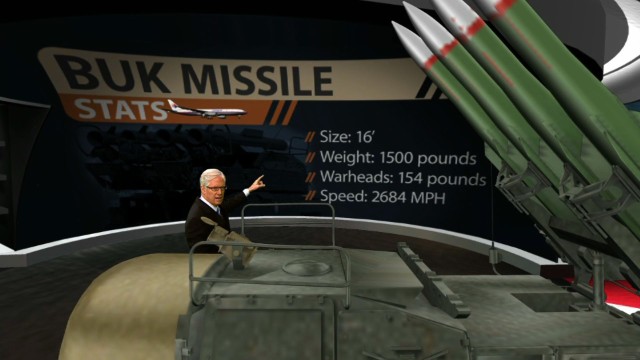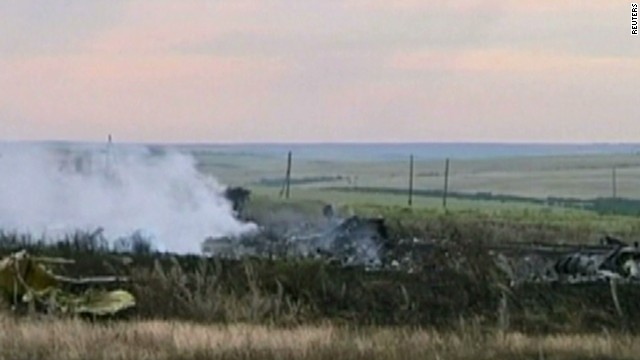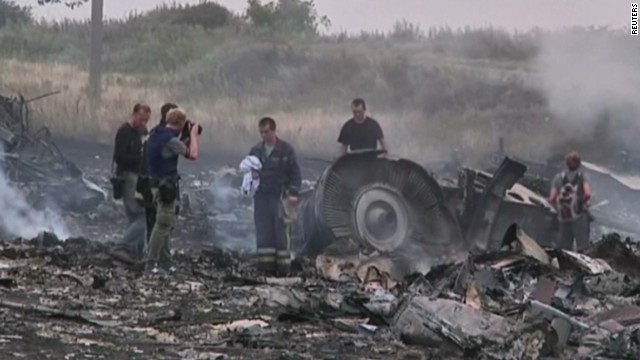Malaysia Airlines Flight 17 crashes in Ukraine
Debris from Malaysia Airlines Flight 17 sits in a field at the crash site in Hrabove, Ukraine, on September 9, 2014. The Boeing 777 was shot down July 17, 2014, over Ukrainian territory controlled by pro-Russian separatists. All 298 people on board were killed. In an October 2015 report, Dutch investigators found the flight was shot down by a warhead that fit a Buk rocket, referring to Russian technology, Dutch Safety Board Chairman Tjibbe Joustra said.
Malaysia Airlines Flight 17 crashes in Ukraine
Australian and Dutch experts examine the area of the crash on August 3, 2014.
Malaysia Airlines Flight 17 crashes in Ukraine
A woman walks with her bicycle near the crash site on August 2, 2014.
Malaysia Airlines Flight 17 crashes in Ukraine
Police secure a refrigerated train loaded with bodies of passengers from Malaysia Airlines Flight 17 as it arrives in a Kharkiv, Ukraine, factory on July 22, 2014.
Malaysia Airlines Flight 17 crashes in Ukraine
A pro-Russian rebel passes wreckage from the crashed jet near Hrabove on Monday, July 21, 2014.
Malaysia Airlines Flight 17 crashes in Ukraine
– Wreckage from the jet lies in grass near Hrabove on July 21, 2014.
Malaysia Airlines Flight 17 crashes in Ukraine
A man covers his face with a rag as members of the Organization for Security and Co-operation in Europe and the Dutch National Forensic Investigations Team inspect bodies in a refrigerated train near the crash site in eastern Ukraine on July 21, 2014.
Malaysia Airlines Flight 17 crashes in Ukraine
Emergency workers carry a victim's body in a bag at the crash site on July 21, 2014.
Malaysia Airlines Flight 17 crashes in Ukraine
A piece of the plane lies in the grass in eastern Ukraine's Donetsk region on July 21, 2014.
Malaysia Airlines Flight 17 crashes in Ukraine
An armed pro-Russian rebel stands guard next to a refrigerated train loaded with bodies in Torez, Ukraine, on Sunday, July 20, 2014.
Malaysia Airlines Flight 17 crashes in Ukraine
Ukrainian State Emergency Service employees sort through debris on July 20, 2014, as they work to locate the deceased.
Malaysia Airlines Flight 17 crashes in Ukraine
A woman covers her mouth with a piece of fabric July 20, 2014, to ward off smells from railway cars that reportedly contained passengers' bodies.
Malaysia Airlines Flight 17 crashes in Ukraine
Toys and flowers sit on the charred fuselage of the jet as a memorial on July 20, 2014.
Malaysia Airlines Flight 17 crashes in Ukraine
People search a wheat field for remains in the area of the crash site on July 20, 2014.
Malaysia Airlines Flight 17 crashes in Ukraine
A woman walks among charred debris at the crash site on July 20, 2014.
Malaysia Airlines Flight 17 crashes in Ukraine
Emergency workers load the body of a victim onto a truck at the crash site on Saturday, July 19, 2014.
Malaysia Airlines Flight 17 crashes in Ukraine
Emergency workers carry the body of a victim at the crash site on July 19, 2014.
Malaysia Airlines Flight 17 crashes in Ukraine
A large piece of the main cabin is under guard at the crash site on July 19, 2014.
Malaysia Airlines Flight 17 crashes in Ukraine
Victims' bodies are placed by the side of the road on July 19, 2014, as recovery efforts continue at the crash site. International officials lament the lack of a secured perimeter.
Malaysia Airlines Flight 17 crashes in Ukraine
A man looks through the debris at the crash site on July 19, 2014.
Malaysia Airlines Flight 17 crashes in Ukraine
An envelope bearing the Malaysia Airlines logo is seen at the crash site on July 19, 2014.
Malaysia Airlines Flight 17 crashes in Ukraine
Armed rebels walk past large pieces of the Boeing 777 on July 19, 2014.
Malaysia Airlines Flight 17 crashes in Ukraine
Ukrainian rescue workers walk through a wheat field with a stretcher as they collect the bodies of victims on July 19, 2014.
Malaysia Airlines Flight 17 crashes in Ukraine
A woman looks at wreckage on July 19, 2014.
Malaysia Airlines Flight 17 crashes in Ukraine
Pro-Russian rebels stand guard as the Organization for Security and Co-operation in Europe delegation arrives at the crash site on Friday, July 18, 2014.
Malaysia Airlines Flight 17 crashes in Ukraine
A woman walks through the debris field on July 18, 2014.
Malaysia Airlines Flight 17 crashes in Ukraine
Pro-Russian rebels stand guard at the crash site.
Malaysia Airlines Flight 17 crashes in Ukraine
Wreckage from Flight 17 lies in a field in Shaktarsk, Ukraine, on July 18, 2014.
Malaysia Airlines Flight 17 crashes in Ukraine
A man covers a body with a plastic sheet near the crash site on July 18, 2014. The passengers and crew hailed from all over the world, including Australia, Indonesia, Malaysia, Germany and Canada.
Malaysia Airlines Flight 17 crashes in Ukraine
A diver searches for the jet's flight data recorders on July 18, 2014.
Malaysia Airlines Flight 17 crashes in Ukraine
Coal miners search the crash site.
Malaysia Airlines Flight 17 crashes in Ukraine
Wreckage from the Boeing 777 lies on the ground July 18, 2014.
Malaysia Airlines Flight 17 crashes in Ukraine
People search for bodies of passengers on July 18, 2014.
Malaysia Airlines Flight 17 crashes in Ukraine
A woman walks past a body covered with a plastic sheet near the crash site July 18, 2014.
Malaysia Airlines Flight 17 crashes in Ukraine
Belongings of passengers lie in the grass on July 18, 2014.
Malaysia Airlines Flight 17 crashes in Ukraine
People inspect the crash site on Thursday, July 17, 2014.
Malaysia Airlines Flight 17 crashes in Ukraine
People walk amid the debris at the site of the crash.
Malaysia Airlines Flight 17 crashes in Ukraine
Debris smoulders in a field near the Russian border.
Malaysia Airlines Flight 17 crashes in Ukraine
Fire engines arrive at the crash site.
Malaysia Airlines Flight 17 crashes in Ukraine
A man stands next to wreckage.
Malaysia Airlines Flight 17 crashes in Ukraine
Debris from the crashed jet lies in a field in Ukraine.
Malaysia Airlines Flight 17 crashes in Ukraine
Family members of those aboard Flight 17 leave Schiphol Airport near Amsterdam, Netherlands.
Malaysia Airlines Flight 17 crashes in Ukraine
A large piece of the plane lies on the ground.
Malaysia Airlines Flight 17 crashes in Ukraine
Luggage from the flight sits in a field at the crash site.
Malaysia Airlines Flight 17 crashes in Ukraine
A couple walks to the location at Schiphol Airport where more information would be given regarding the flight.
Malaysia Airlines Flight 17 crashes in Ukraine
Flight arrivals are listed at the Kuala Lumpur International Airport in Sepang, Malaysia.
Malaysia Airlines Flight 17 crashes in Ukraine
Debris from the Boeing 777, pictured on July 17, 2014.
Malaysia Airlines Flight 17 crashes in Ukraine
A man inspects debris from the plane.
Malaysia Airlines Flight 17 crashes in Ukraine
Wreckage from the plane is seen on July 17, 2014.
Malaysia Airlines Flight 17 crashes in Ukraine
A man talks with security at Schiphol Airport on July 17, 2014.
Malaysia Airlines Flight 17 crashes in Ukraine
Wreckage burns in Ukraine.
Malaysia Airlines Flight 17 crashes in Ukraine
A man stands next to the wreckage of the airliner.
Malaysia Airlines Flight 17 crashes in Ukraine
Malaysia Airlines Flight 17 crashes in Ukraine
People inspect a piece of wreckage believed to be from Malaysia Airlines Flight 17. This image was posted to Twitter.
Malaysia Airlines Flight 17 crashes in Ukraine
Malaysia Airlines Flight 17 crashes in Ukraine
Malaysia Airlines Flight 17 crashes in Ukraine
Malaysia Airlines Flight 17 crashes in Ukraine






























































































































